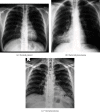The Use of Chest Radiographs and Machine Learning Model for the Rapid Detection of Pneumonitis in Pediatric
- PMID: 35909473
- PMCID: PMC9334107
- DOI: 10.1155/2022/5260231
The Use of Chest Radiographs and Machine Learning Model for the Rapid Detection of Pneumonitis in Pediatric
Retraction in
-
Retracted: The Use of Chest Radiographs and Machine Learning Model for the Rapid Detection of Pneumonitis in Pediatric.Biomed Res Int. 2023 Jun 21;2023:9792648. doi: 10.1155/2023/9792648. eCollection 2023. Biomed Res Int. 2023. PMID: 37388383 Free PMC article.
Abstract
Pneumonia is a common lung disease that is the leading cause of death worldwide. It primarily affects children, accounting for 18% of all deaths in children under the age of five, the elderly, and patients with other diseases. There is a variety of imaging diagnosis techniques available today. While many of them are becoming more accurate, chest radiographs are still the most common method for detecting pulmonary infections due to cost and speed. A convolutional neural network (CNN) model has been developed to classify chest X-rays in JPEG format into normal, bacterial pneumonia, and viral pneumonia. The model was trained using data from an open Kaggle database. The data augmentation technique was used to improve the model's performance. A web application built with NextJS and hosted on AWS has also been designed. The model that was optimized using the data augmentation technique had slightly better precision than the original model. This model was used to create a web application that can process an image and provide a prediction to the user. A classification model was developed that generates a prediction with 78 percent accuracy. The precision of this calculation could be improved by increasing the epoch, among other subjects. With the help of artificial intelligence, this research study was aimed at demonstrating to the general public that deep-learning models can be created to assist health professionals in the early detection of pneumonia.
Copyright © 2022 Khalaf Alshamrani et al.
Conflict of interest statement
The authors declare that they have no conflicts of interest.
Figures


















References
-
- Daod I., Ibrahim R., Hussein A., Norsamsi N., Mazlan N. Knowledge of pneumonia among nursing staff in Mosul hospitals, Iraq. International Journal of Medical Toxicology & Legal Medicine. . 2020;23(3and4):107–116. doi: 10.5958/0974-4614.2020.00054.6. - DOI
-
- Jaiswal A., Tiwari P., Kumar S., Gupta D., Khanna A., Rodrigues J. Identifying pneumonia in chest X-rays: a deep learning approach. Measurement . 2019;145:511–518. doi: 10.1016/j.measurement.2019.05.076. - DOI
Publication types
MeSH terms
LinkOut - more resources
Full Text Sources

